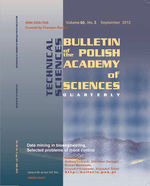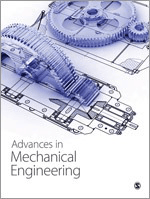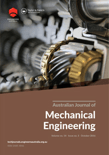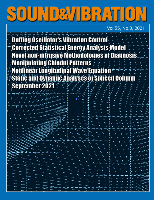
International Journal of Mechanical System Dynamics
Scope & Guideline
Transforming Research into Mechanical Engineering Solutions
Introduction
Aims and Scopes
- Mechanical System Dynamics and Control:
The journal primarily focuses on the dynamics of mechanical systems, including the modeling, analysis, and control of vibrational and dynamic responses in various engineering applications. - Innovative Engineering Solutions:
It emphasizes the development of novel engineering solutions, such as advanced materials, energy systems, and control methods, aimed at enhancing performance and efficiency in mechanical systems. - Interdisciplinary Research:
The journal encourages interdisciplinary research that integrates mechanical engineering with fields like materials science, computer science, and data analytics, fostering holistic approaches to system design. - Application of Advanced Technologies:
There is a consistent focus on the application of emerging technologies such as machine learning, neural networks, and advanced simulation techniques in the analysis and optimization of mechanical systems. - Experimental and Numerical Methods:
The journal publishes research employing both experimental and numerical methodologies to validate theoretical models, ensuring practical relevance and applicability of findings.
Trending and Emerging
- Machine Learning Applications:
The increasing integration of machine learning techniques in mechanical system dynamics, such as predictive modeling and fault diagnosis, highlights a trend towards data-driven methodologies that enhance system performance. - Advanced Vibration Control Techniques:
Research focusing on sophisticated vibration control methods, including nonlinear and adaptive control strategies, is gaining traction as industries seek to mitigate vibrations in various mechanical applications. - Smart Materials and Structures:
There is a growing interest in the use of smart materials and structures that respond dynamically to environmental changes, showcasing innovative approaches to enhance mechanical system functionality. - Nonlinear Dynamics and Stochastic Analysis:
Emerging themes in nonlinear dynamics and stochastic analysis reflect the complexities of modern mechanical systems, addressing real-world uncertainties and enhancing the robustness of system designs. - Integration of AI and Robotics:
The convergence of AI and robotics in mechanical systems is becoming increasingly prominent, with research exploring the dynamics of robotic systems and their applications in automation and manufacturing.
Declining or Waning
- Traditional Mechanical Systems:
There has been a noticeable decline in papers focusing solely on classical mechanical systems without the integration of advanced technologies or methodologies, reflecting a shift towards more innovative and interdisciplinary approaches. - Basic Theoretical Models:
Research centered on basic theoretical models without practical applications or advanced computational methods appears to be waning, as the journal increasingly favors studies that demonstrate real-world applicability and technological integration. - Static Analysis:
The focus on static analysis of mechanical systems is decreasing, possibly due to the growing importance of dynamic behavior and real-time analysis in contemporary engineering challenges. - Conventional Materials Research:
Papers dedicated to traditional materials research are being outpaced by studies on advanced materials and composites, indicating a shift towards innovative material applications in dynamic systems. - Simplistic Control Strategies:
There is a diminishing trend in the publication of simplistic control strategies, as the emphasis has moved towards more complex, adaptive, and intelligent control systems that leverage modern computational techniques.
Similar Journals

Bulletin of the Polish Academy of Sciences-Technical Sciences
Exploring Innovations in Engineering and TechnologyBulletin of the Polish Academy of Sciences-Technical Sciences is a distinguished peer-reviewed journal published by the Polish Academy of Sciences, focusing on a broad spectrum of disciplines within technical sciences. With an E-ISSN of 2300-1917 and an established presence since 1983, this journal transitioned to an Open Access model in 2009, ensuring wide dissemination of innovative research findings. Recognized for its contributions, the journal boasts notable rankings in various categories, including Q4 in Artificial Intelligence and Q3 in fields such as Computer Networks and Communications and Atomic and Molecular Physics, as indicated by its Scopus rankings. With its strategic location in Warsaw, Poland, and a commitment to advancing knowledge and technology, the Bulletin serves as a vital platform for researchers, professionals, and students to share and engage with cutting-edge developments in engineering and related fields. Emphasizing high-quality research, this journal offers an essential resource for anyone looking to enhance their understanding of current trends and breakthroughs in technical sciences.

Engineering Research Express
Advancing Engineering Knowledge, One Article at a Time.Engineering Research Express is a peer-reviewed journal published by IOP Publishing Ltd, specializing in the diverse field of engineering. Since its inception in 2019, the journal has rapidly established itself as an important platform for disseminating cutting-edge research across various engineering disciplines, evidenced by its classification in the Q3 quartile in the 2023 Engineering (miscellaneous) category and its positioning within the 53rd percentile in Scopus rankings. With a commitment to open access, Engineering Research Express aims to foster collaboration and knowledge sharing among researchers, professionals, and students by providing unrestricted availability of its articles. This journal not only covers foundational concepts but also explores innovative applications and emerging trends within the engineering domain. Its aim is to encourage interdisciplinary approaches and the integration of novel technologies in engineering practices, making it an invaluable resource for those looking to advance their understanding and contribute to this dynamic field of study.

Advances in Mechanical Engineering
Elevating Research Standards in Mechanical EngineeringAdvances in Mechanical Engineering is a premier open-access journal published by SAGE Publications Ltd, dedicated to the advancement of theoretical and applied research in the field of mechanical engineering. With an ISSN of 1687-8132 and an E-ISSN of 1687-8140, this journal has been a vital resource for scholars and practitioners since its inception in 2009. Housed in the United States, it operates under a commitment to ensure free and immediate access to its high-quality content, enhancing collaboration and innovation across the global engineering community. With a noteworthy Q2 ranking in the mechanical engineering category and a solid Scopus rank placing it in the 59th percentile, the journal serves as an influential platform for cutting-edge research, theoretical advancements, and comprehensive reviews. As the field evolves, Advances in Mechanical Engineering continues to cater to the rigorous needs of researchers, professionals, and students, striving to transform knowledge into tangible engineering solutions. This journal's commitment to excellence makes it a significant contributor to the mechanical engineering field, encouraging dynamic discussions and implications for the future.

FDMP-Fluid Dynamics & Materials Processing
Unveiling the Dynamics Behind Material TransformationFDMP-Fluid Dynamics & Materials Processing, published by TECH SCIENCE PRESS, stands as a significant contribution to the field of materials science, specifically focusing on the intricate relationships between fluid dynamics and material processing. With an ISSN of 1555-256X and an E-ISSN of 1555-2578, this journal offers an open-access platform where researchers can disseminate their work broadly, promoting collaboration and innovation among professionals and students alike. Established in 2007 and continuously evolving through to 2024, the journal is classified in the Q4 category of materials science, ranking at #347 out of 463 in the Scopus database, signifying its niche yet crucial role in the academic community. By focusing on the dynamic interplay between fluid behavior and material properties, FDMP addresses contemporary challenges and advances in material processing techniques. The journal plays a pivotal role for academics and industry professionals seeking to push the boundaries of knowledge and application in materials science.

Australian Journal of Mechanical Engineering
Championing Excellence in Mechanical Engineering Research and Application.The Australian Journal of Mechanical Engineering is a distinguished publication in the realm of mechanical engineering, dedicated to advancing the knowledge and application of engineering principles within the industry. Published by TAYLOR & FRANCIS LTD in the United Kingdom, this journal has been integral to the field since its inception, featuring a range of peer-reviewed research articles, reviews, and technical notes that collectively aim to bridge theoretical research with practical applications. With an impressive Scopus ranking of #271 out of 672 in Mechanical Engineering, positioning it within the 59th percentile, the journal continues to uphold rigorous academic standards, currently occupying Q3 in the 2023 quartile rankings. Researchers, professionals, and students alike will benefit from its comprehensive coverage and insightful contributions, providing a vital platform for knowledge exchange and innovation in mechanical engineering.

Mechatronic Systems and Control
Fostering Excellence in Control Systems ResearchMechatronic Systems and Control is a prestigious journal published by ACTA PRESS, dedicated to the advancing fields of mechatronics, control systems, and their various applications. Established in 2018, this journal serves as a vital platform for researchers and professionals to disseminate innovative findings that bridge the gap between mechanical engineering, electronics, computer science, and control systems. With an ISSN of 2561-1771 and an E-ISSN of 2561-178X, it operates from Canada’s vibrant academic environment, specifically from Calgary, Alberta. Although it is indexed in lower quartiles in 2023 in the fields of Computer Science Applications and Control and Systems Engineering, it presents an opportunity for emerging scholars to contribute and enhance their visibility in this interdisciplinary field. As a strictly non-open access journal, Mechatronic Systems and Control provides subscription-based access which ensures high-quality content delivery. This journal is instrumental for those pursuing advancements in technological convergence and represents an essential resource for academics and students alike seeking to understand the complexities of modern control systems.

Jordan Journal of Mechanical and Industrial Engineering
Advancing Engineering Excellence Through Innovative ResearchThe Jordan Journal of Mechanical and Industrial Engineering, published by HASHEMITE UNIVERSITY, is a distinguished platform for disseminating research in the fields of mechanical and industrial engineering. Established in 2009, this journal has made significant strides in contributing to the body of knowledge within its scope, as evidenced by its current Q3 ranking in both Industrial and Manufacturing Engineering and Mechanical Engineering categories for 2023. Researchers and practitioners alike can benefit from the journal's focus on contemporary developments, innovative methodologies, and empirical investigations that address real-world challenges. While the journal operates under a traditional publishing model, it remains committed to enhancing the dissemination of knowledge through accessible research findings. Scholars will find value in the journal’s insights, as it garners attention within Scopus, ranking as #195 in Industrial and Manufacturing Engineering and #380 in Mechanical Engineering. With its address located at the Deanship of Academic Research & Graduate Studies, PO Box 330127, Zarka, Jordan, the journal serves as a vital resource for the academic community seeking to advance their expertise in engineering disciplines.

MECCANICA
Bridging Disciplines in Physics and Mechanical EngineeringMECCANICA, an esteemed journal published by Springer, stands at the forefront of research in the fields of Condensed Matter Physics, Mechanical Engineering, and Mechanics of Materials. Established in 1966 and continuing through 2024, this journal provides a robust platform for the dissemination of innovative research and advancements in these increasingly interconnected domains. With an impressive 2023 ranking placing it in the Q2 category across multiple fields, MECCANICA boasts a Scopus rank of #198 in Mechanical Engineering, #150 in Condensed Matter Physics, and #141 in Mechanics of Materials, highlighting its significance and influence within the scholarly community. The journal aims to foster dialogue among researchers, professionals, and students, facilitating the exchange of cutting-edge ideas and methodologies crucial for overcoming contemporary engineering and physics challenges. Readers can access a wealth of knowledge through its comprehensive articles, and while it does not currently offer open access, the journal remains instrumental in shaping the future of engineering and physical sciences.

International Journal of Dynamics and Control
Fostering Excellence in Dynamic Systems EngineeringInternational Journal of Dynamics and Control, published by SPRINGERNATURE, is a prestigious academic journal aimed at advancing the fields of Civil and Structural Engineering, Control and Optimization, Electrical, Electronic, and Mechanical Engineering, as well as Modeling and Simulation. With an ISSN of 2195-268X and an E-ISSN of 2195-2698, this journal focuses on high-quality research that addresses complex dynamic systems and control methodologies essential for innovation and progress in engineering disciplines. The journal has achieved significant recognition, being ranked in the second quartile for multiple categories in 2023, which underscores its impact and relevance within the academic community. Although it operates under subscription access, its rigorous peer-review process ensures that published articles meet the highest standards of scientific excellence. Researchers, professionals, and students alike will find valuable insights and methodologies that inform their work and inspire future studies in dynamic systems and controls.

SOUND AND VIBRATION
Pioneering Research in Safety and Mechanical DynamicsSOUND AND VIBRATION, published by TECH SCIENCE PRESS, is a pivotal journal in the fields of Acoustics and Ultrasonics, Mechanical Engineering, and Safety, Risk, Reliability, and Quality. With an ISSN of 1541-0161, this journal has been a reliable source of innovative research and developments from its inception in 1976 through to 2024. Although it currently ranks in the Q4 category on Scopus, it serves as a vital platform for the dissemination of studies focusing on sound and vibration phenomena, contributing to the understanding and advancement of engineering principles. Researchers and professionals are encouraged to utilize this journal to gain insights into critical acoustic applications and mechanical dynamics. While SOUND AND VIBRATION does not operate under an Open Access model, it remains a valuable asset for anyone committed to exploring the various ramifications of sound and vibration in engineering and applied sciences.